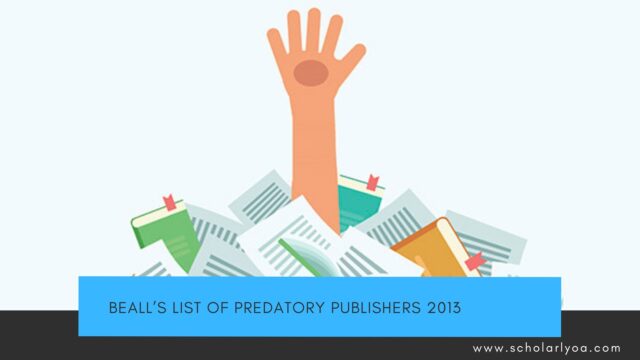
In August 2012, I published the first edition of my Criteria for Determining Predatory Open-Access Publishers. I received many helpful comments and am now publishing a second edition of the work. I am especially grateful to Bill Cohen and Dr. Michael W. Firmin for their helpful suggestions. Also, thanks to all the those who left helpful comments or who sent in emails with suggestions. This document is also available as a PDF.
Criteria for Determining Predatory Open-Access Publishers
By Jeffrey Beall
2nd edition / December 1, 2012
1. Complete an analysis of the publisher’s content, practices, and websites according to ethical standards established by membership organizations.
A. Open Access Scholarly Publishers Association (OASPA) Code of Conduct
B. Committee on Publication Ethics (COPE) Code of Conduct for Journal Publishers [PDF]
C. International Association of Scientific, Technical & Medical Publishers (STM) Code of Conduct
2. Complete an analysis of the publisher’s content, practices, and websites: contact the publisher if necessary, read statements from the publisher’s authors about their experiences with the publisher, and determine whether the publisher commits any of the following practices (below) that are known to be committed by predatory publishers.
n.b. Some journals publish independently of any publisher, but in most cases, we evaluate journals that are part of a publisher’s fleet. The practices described below are meant to apply both to independent journals and to publishers with multiple journals in their portfolios.

Editor and Staff
- The publisher’s owner is identified as the editor of all the journals published by the organization.
- No single individual is identified as the journal’s editor.
- The journal does not identify a formal editorial/review board.
- No academic information is provided regarding the editor, editorial staff, and/or review board members (e.g., institutional affiliation).
- Evident data exist showing that the editor and/or review board members do not possess academic expertise to reasonably qualify them to be publication gatekeepers in the journal’s field.
- Two or more journals have duplicate editorial boards (i.e., same editorial board for more than one journal).
- The journals have an insufficient number of board members, have concocted editorial boards (made up names), include scholars on an editorial board without their knowledge or permission, have board members who are prominent researchers but exempt them from any contributions to the journal except the use of their names and/or photographs.
Business Management
The publisher…
- Demonstrates a lack of transparency in publishing operations.
- Has no policies or practices for digital preservation.
- Depends on author fees as the sole and only means of operation with no alternative, long-term business plan for sustaining the journal through augmented income sources.
- Begins operations with a large fleet of journals, often using a template to quickly create each journal’s home page.
- Provides insufficient information or hides information about author fees, offering to publish an author’s paper and later sending a previously-undisclosed invoice.
Integrity
- The name of a journal is incongruent with the journal’s mission.
- The name of a journal does not adequately reflect its origin (e.g., a journal with the word “Canadian” or “Swiss” in its name that has no meaningful relationship to Canada or Switzerland).
- The journal falsely claims to have an impact factor, or uses some made up measure (e.g. view factor), feigning international standing.
- The publisher sends spam requests for peer reviews to scholars unqualified to review submitted manuscripts.
- The publisher falsely claims to have its content indexed in legitimate abstracting and indexing services or claims that its content is indexed in resources that are not abstracting and indexing services
- The publisher dedicates insufficient resources to preventing and eliminating author misconduct, to the extent that the journal or journals suffer from repeated cases of plagiarism, self-plagiarism, image manipulation, and the like.
- The publisher asks the corresponding author for suggested reviewers and the publisher subsequently uses the suggested reviewers without sufficiently vetting their qualifications or authenticity. (This protocol also may allow authors to create faux online identities in order to review their own papers).

Other
A predatory publisher may …
- Publish papers already published in other venues/outlets without providing appropriate credits
- Use language claiming to be a “leading publisher” even though the publisher may only be a startup or a novice organization.
- Operate in a Western country chiefly for the purpose of functioning as a vanity press for scholars in a developing country.
- Do minimal or no copyediting.
- Publish papers that are not academic at all, e.g. essays by laypeople or
obvious pseudo-science. - Have a “contact us” page that only includes a web form, and the publisher hides or does not reveal its location
The following practices are considered to be reflective of poor journal standards and, while they do not equal predatory criteria, potential authors should give due consideration to these items prior to manuscript submissions:
- The publisher copies “authors guidelines” verbatim (or with minor editing) from other publishers.
- The publisher lists insufficient contact information, including contact information that does not clearly state the headquarters location or misrepresents the headquarters location (e.g., through the use of addresses that are actually mail drops).
- The publisher publishes journals that are excessively broad (e.g., Journal of Education) in order to attract more articles and gain more revenue from author fees.
- The publisher publishes journals that combine two or more fields not normally treated together (e.g., International Journal of Business, Humanities and Technology).
- The publisher requires a transfer of copyright and retains copyright on journal content. Or the publisher requires the copyright transfer upon submission of a manuscript.
- The publisher has poorly maintained websites, including dead links, prominent misspellings and grammatical errors on the website.
- The publisher makes unauthorized use of licensed images on their website, taken from the open web, without permission or license from the copyright owners.
- The publisher engages in excessive use of spam email to solicit manuscripts or editorial board memberships
- The publishers’ officers use email addresses that end in .gmail.com, yahoo.com some other free email supplier
- The publisher fails to state licensing policy information on articles or shows a lack of understanding of well-known OA journal article licensing standards.
- The publisher lacks a published article retraction policy or retracts articles without a formal statement; also the publisher does not publish corrections or clarifications and does not have a policy for these issues.
- The publisher does not use ISSN numbers, DOI numbers or uses them improperly.
- For the name of the publisher, the publisher uses names such as “Network,” “Center,” “Association,” “Institute,” and the like when it is only a publisher and does not meet the definition of the term used.
- The publisher has excessive advertising on its site to the extent that it interferes with site navigation and content access.
- The publisher has no membership in industry associations and/or intentionally fails to follow industry standards.
- The publisher includes links to legitimate conferences and associations on its main website, as if to borrow from other organizations’ legitimacy, and emblazon the new publisher with the others’ legacy value.
- The publisher displays prominent statements that promise rapid publication and/or unusually quick peer review.
- The publisher focuses on authors (not readers) and on getting their fees at the expense of due quality and offers few or no value adds to readers such as RSS feeds, hotlinked references, or the like.
- The publisher creates a publishing operation that is set up and run by a single individual who engages in rapacious entrepreneurial behavior. The individual might have business administration experience, and the site may have business journals but it also has journals that are outside the experience of the entrepreneur or anyone on staff.
- The publisher or its journals are not listed in standard periodical directories or are not widely cataloged in library databases.
- The publisher copies or egregiously mimics journal titles from other publishers.
- The publisher uses text on the publisher’s main page that describes the open access movement and then foists the publisher as if the publisher is active in fulfilling the movement’s values and goals.
- None of the members of a particular journal’s editorial board have ever published an article in the journal.
This entry was posted on Friday, November 30th, 2012 at 9:46 AM and is filed under Scholarly Open-Access Publishers, Unethical Practices. You can follow any responses to this entry through the RSS 2.0 feed. You can leave a response, or trackback from your own site.










